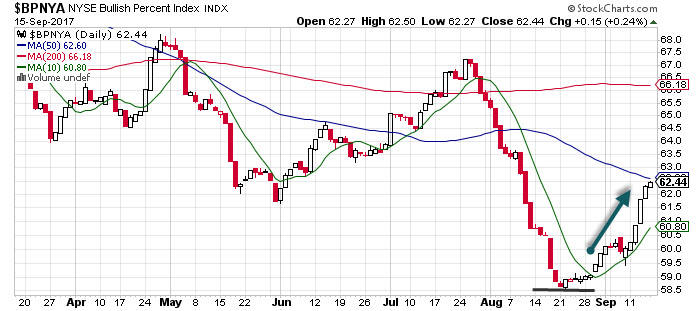
As I have learned and taught about technical analysis over the years, it is certainly not a sophisticated science. If you have a set of eyes, can see recognizable patterns that repeat over and over again we can draw some conclusions, and from that high probabilities of success. There are no guarantees of course, but I'll take the high odds of human behavior repeating over and over again.
A couple of coincident indicators I look at include new highs/lows and the bullish percent indicator. These show us the momentum of buyers and sellers in real time and give off some very power signals to follow.
New highs/lows are a basic reading that shows how prices of individual stocks are doing and being responded to. I look at annual highs and lows as to the health/status of the market. New highs often scare off new buyers, but when we view the data through a series of timeframes we can see an accumulation (or distribution) pattern play out. This could be considered a yearly breadth indicator.
Recently new highs started to climb but not to the levels seen in July. However, the separation of highs vs low started to widen, and that was significant. When buyers continue to push prices up that tends to be quite bullish.
On the other hand, when the new highs started to fall in August and new lows began to climb that was a time to become a bit cautious. Indeed, we witnessed a couple of sharp declines during this time, but that soon passed. Currently new highs have expanded nicely and are likely to buoy stocks as they had previously. Strong price action attracts more funds to stocks.
The bullish percent indicator signals how many stocks are on a buy signal on a point/figure chart. This analysis plots price against changes in direction using x's (prices rising) and o's (prices dropping) in column boxes. Technicians have been using this form for many years and it fires off some very reliable signals. A key level when looking at the bullish percent indicator is the 50 level, a cross below it could be considered rather bearish, while a cross above is a sign of bullishness.
Some might look at the chart from a divergence standpoint, and that might prove correct. For instance, the bullish percent, while showing strong momentum now is not anywhere close to the levels in July - and we are at all time highs again. Further, the bullish percent only rallied to the June lows in the indicator, which may now represent resistance - and a stall may be coming. These are all true, but we'll have to see how it plays out here, other indicators are not in line with a bearish outcome.
Recently, the bullish percent indicator for most indices (S&P 500, NYSE, Nasdaq and Industrials) hit an important inflection point in mid August. We saw the indicator approach the 50 area but didn't quite get there, and turned higher and now has some very strong wind at its back. That is a good sign of health for the markets, as more stocks show up on the buy signal column.
Bottom line, these two indicators are not difficult to understand or interpret, and the give us a good sense of market direction with using much sophistication, other than using our eyes. Pay attention when these fire off signals such as we have now, powerful trends have a tendency to continue onward.